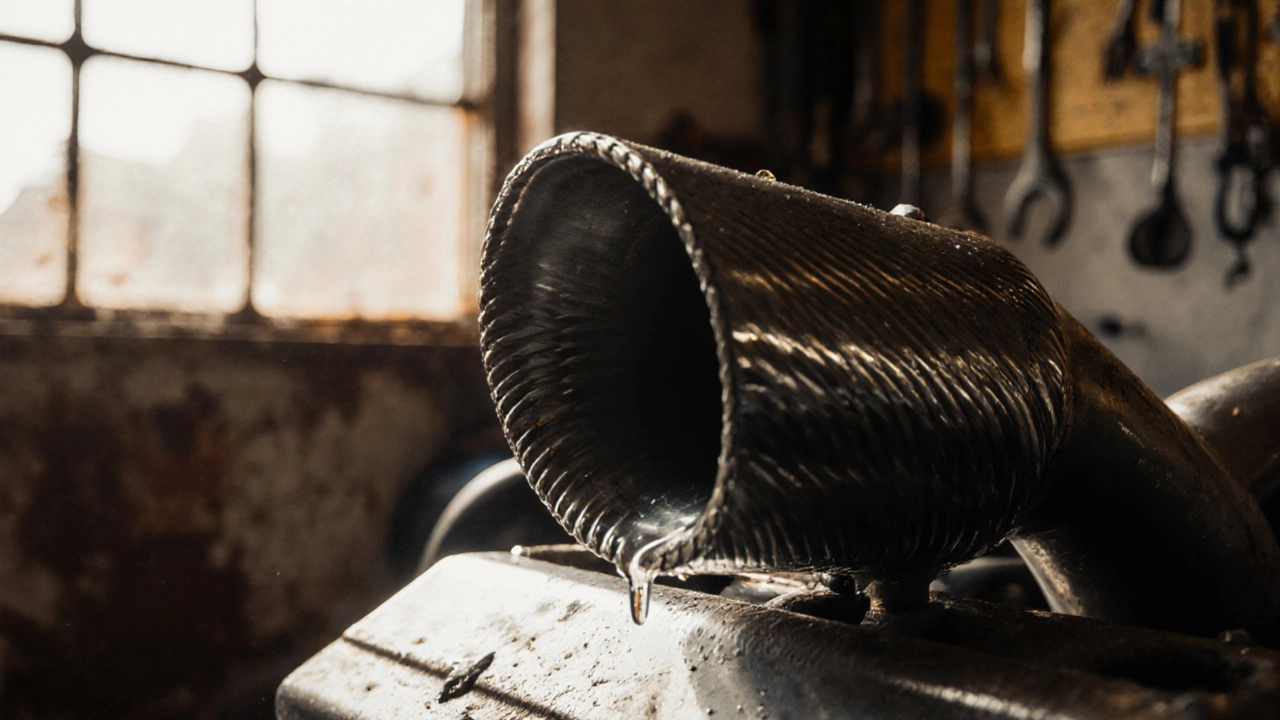Exhaust Tip Sound Enhancer Calculator
This tool estimates the potential decibel increase you might achieve by upgrading your exhaust tip based on material and shape selection.
Exhaust Tip is a terminal component that shapes and amplifies the sound exiting an exhaust system, typically made from metal or composite materials and available in a range of designs. When you hear that deep rumble or sharp crackle, the tip is the final sculptor of the note. Picking the right tip isn’t about flash; it’s about how the tip works with the rest of your Exhaust System, the Muffler, and the engine’s exhaust flow. Below we break down the science, the materials, and the real‑world choices that let you hear your car the way you want.
How an Exhaust Tip Affects Sound
The tip is more than a decorative flare. It changes the acoustic wave by influencing three core parameters:
- Back‑pressure: A restrictive tip can raise pressure in the system, boosting low‑end torque but also adding a louder, deeper tone.
- Frequency filtering: Certain shapes dampen high‑frequency whine while emphasizing the mid‑range growl that many enthusiasts love.
- Flow rate: Measured in cubic feet per minute (CFM), a tip that allows smooth airflow reduces turbulence, resulting in a clearer note.
When you combine these effects with the Resonator and the muffler’s internal chambers, you get a distinct signature. That’s why a cheap, ill‑fitting tip can make a perfectly tuned system sound tinny or muffled.
Key Factors That Define the Sound of a Tip
Below are the five variables that most directly shape the audible result.
- Material - Different alloys vibrate uniquely, affecting decibel output and tonal character.
- Shape - Straight‑through, C‑cut, turbo, and flare designs each influence wave reflection.
- Diameter - Larger diameters lower the pitch; smaller diameters raise it.
- Length - Longer tips add echo, acting like a miniature pipe organ.
- Installation method - Welded tips provide a rigid seal, while slip‑on tips can introduce micro‑gaps that alter resonance.
Let’s dig into the material factor first, because that’s where most drivers see the biggest audible swing.
Material Showdown: Stainless Steel vs. Titanium vs. Carbon Fiber
Each material brings a blend of weight, durability, and acoustic profile. Below is a side‑by‑side look that helps you decide which matches your performance goals and budget.
| Material | Weight (g/m) | Durability | Typical Decibel Gain | Price Range (USD) |
|---|---|---|---|---|
| Stainless Steel | 150 | High - resists rust, withstands >500°C | +1.5 dB (mid‑range emphasis) | $80‑$150 |
| Titanium | 90 | Very high - lightweight, excellent heat resistance | +2.0 dB (broader frequency response) | $180‑$300 |
| Carbon Fiber | 70 | Moderate - can delaminate under extreme heat | +1.0 dB (sharp, focused tone) | $250‑$400 |
In plain English, if you want the loudest, most balanced growl without breaking the bank, stainless steel is the workhorse. If you chase weight savings for a track day car, titanium’s lighter mass and wider frequency coverage make it the best exhaust tip for performance‑oriented builds. Carbon fiber is the style statement - it sounds great, looks sleek, but you’ll need to watch heat soak.
Shape Matters: From C‑Cut to Turbo Flare
Even with the same material, the tip’s geometry dramatically changes the sound. Here are the most common shapes and their sonic footprints:
- C‑Cut - A short, angled cut that creates a sharp crackle, ideal for hot‑rod aesthetics.
- Turbo‑style (bulged) - Expands the pipe’s cross‑section, deepening the tone and adding a resonant “whoosh”.
- Flare (cone) - Gradually widens the exit, smoothing high‑frequency harshness.
- Straight‑through - Minimal interference, preserves the raw note generated by the muffler.
Pair a turbo‑style tip with titanium for a track‑day roar, or choose a C‑cut stainless steel tip if you want that classic street‑muscle snap.

Diameter, Length, and Flow Rate: Tuning the Volume
The Exhaust Tip Diameter sets the fundamental pitch. A 2.5‑inch tip on a V8 will sound deeper than a 2‑inch tip on the same engine. Length adds echo; a 6‑inch extension can raise perceived volume by up to 1 dB due to added resonance.
Flow rate, expressed in CFM, dictates how much air can escape without turbulence. A tip that supports at least 450CFM for a four‑cylinder turbocharged engine keeps the note clean, while a restrictive 250CFM tip introduces a throaty rasp that some drivers love but can hurt performance.
Choosing the Right Tip for Your Car
Here’s a quick decision matrix to match vehicle type with tip attributes:
- Daily driver (compact or sedan) - Go stainless steel, 2‑inch diameter, flare shape. You get a pleasant growl without excessive volume.
- Performance coupe or sports car - Opt for titanium, 2.5‑inch diameter, turbo‑style. Expect a louder, broader frequency response.
- Off‑road truck - Choose stainless steel or chrome‑plated, C‑cut, with a durable finish to survive mud and debris.
- Track build - Lightweight titanium, straight‑through, 3‑inch diameter, welded installation for maximum flow and minimal back‑pressure.
Remember, the tip works with the entire exhaust train. A high‑flow muffler paired with a restrictive tip will negate the muffler’s gains, and vice‑versa.
Installation Tips and Common Pitfalls
Even the best‑designed tip can under‑perform if installed wrong. Follow these steps:
- Measure the pipe’s outer diameter accurately; use a caliper.
- Clean the mating surface - any residue creates micro‑gaps.
- Choose the attachment method:
- Welded - Best seal, permanent, requires a qualified welder.
- Slip‑on with clamp - Quick DIY, but check for vibration‑induced looseness.
- Torque any clamps to the manufacturer’s spec (usually 12‑15Nm).
- After installation, rev the engine from idle to 5,000rpm while listening for odd rattles. A loose fit will produce a high‑pitched squeal.
Don’t overlook heat shielding. A tip that sits too close to the exhaust pipe can warp, especially with stainless steel on a hot manifold.
Maintenance - Keep the Sound Consistent
Regular care ensures the tip stays both functional and loud‑loving:
- Wash with mild soap and water; avoid abrasive pads that scratch the finish.
- For stainless steel, apply a protective coating every 6‑12 months to ward off rust.
- Inspect the joint for cracks after every 10,000km; a micro‑crack can cause a sudden drop in dB.
- Check for carbon buildup inside the tip - a thin layer can muffle high frequencies.
Next Steps - Testing Your New Sound
Once installed, fire up the engine on a quiet road or a dyno. Use a decibel meter at a 1‑meter distance; compare the reading to the stock setup. Many drivers see a 1‑3dB increase, which is both audible and legal in most regions.
If you crave a deeper tone after the first run, consider swapping to a larger diameter or a turbo‑style tip. If the note feels too aggressive, a flare or smaller diameter will tame it.

Frequently Asked Questions
Do exhaust tips really make a car louder?
Yes. While the muffler does most of the sound shaping, the tip adds 1‑3dB by influencing back‑pressure, resonance, and airflow turbulence. A well‑chosen tip can noticeably amplify the tone without violating noise regulations.
Is stainless steel worth the cost over cheap chrome‑plated tips?
Stainless steel offers superior heat resistance and corrosion protection, which translates to a longer life and a steadier sound. Cheap chrome‑plated tips may look flashy but can peel or rust, changing the acoustic properties over time.
Can I fit a larger‑diameter tip on a stock exhaust?
Usually yes, as long as the pipe’s outer diameter matches the tip’s inner bore. If the gap is too large you’ll need a reducer or a slip‑on adapter to maintain a proper seal and avoid unwanted vibration.
What is the optimal tip shape for a track car?
A straight‑through or turbo‑style tip in lightweight titanium provides the least restriction, preserving flow while delivering a clear, high‑frequency edge that helps you hear engine cues on the track.
Do I need to re‑tune my ECU after changing the tip?
Typically no. A tip’s impact on exhaust pressure is minor compared to changes in the muffler or header. However, if you combine a larger tip with a high‑flow exhaust, a quick ECU check can ensure optimal air‑fuel ratios.
How often should I clean my exhaust tip?
Every 5,000‑10,000km, or whenever you notice a buildup of carbon or soot. A simple soak in warm soapy water and a soft brush keeps the surface smooth and the sound consistent.

